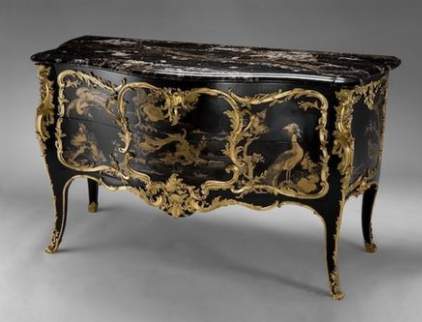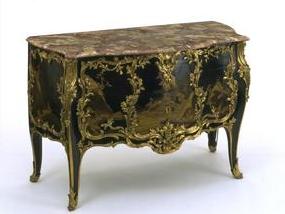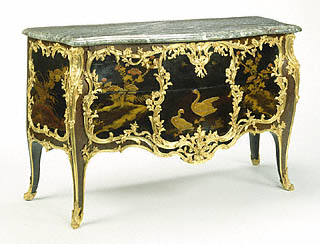By guest columnist Paul Paradis, Art Historian, Specialist Consultant in French Furniture and Decorative Arts
Note from Beth Arnold: My friend Paul told me this fascinating story about something that had happened at an art auction recently, and I asked him to write about it and use my blog as an outlet. Paul earned an advanced degree from Christie's Paris in the history of French art with an emphasis on furniture and objets d'art, and subsequently trained at Christie's auction house in the furniture department. His various free lance projects have included research for the Rothschild collection (formerly at the historic Hôtel Lambert) as well as for Parisian experts on Royal French Furniture and ormolu. He was also my consultant for the Yves Saint Laurent-Pierre Bergé sale last February for the American Vogue.
Rooms 5 and 6 at the Hôtel Drouot in Paris were buzzing last Friday. This particular auction had already attracted a lot of attention for several reasons. First, the budding new auction house organizing the sale had previously been refused access to the Drouot salerooms for reasons that remain opaque in a very French way. Drouot's 16 dingy yet hallowed rooms receive more than 6,000 visitors per day, and host auctions six days out of seven of virtually any type of objet d'art, postage stamp or stuffed deer head the mind can conjure. More than just a building, Drouot is an institution comprised of close to 100 SVVs (Sociétés de Ventes Volontaires) the equivalent of small licensed auction houses, most who are shareholders in the enterprise as well as renters of the space used for auctions.
The new auction house had made a not-so-discreet entrance into the Paris art world in early 2009, boldly announcing in the trade paper Journal des Arts that their main shareholder was a wealthy French investor/collector living in London and that they possessed substantial resources. Their exclusion from use of the Drouot infrastructure is puzzling yet they seemed to have circumvented it for this particular sale by allying themselves with powerhouse auctioneers Didier LaFarge and Dominique Giafferi, both respected shareholders in the institution. I also noted that the name of the new auction house appears nowhere on the sale catalogue, although their logo is displayed on the top of the cover, visible to those who know it.

Commode by Joseph Baumhauer, recently sold for €1 350 000 (Photo: Etude Giafferi)
Another reason for the buzz behind this auction was the inclusion of a major and rare piece of 18th Century French furniture, a Louis XV commode decorated with Japanese lacquer, stamped by the cabinet maker Joseph Baumhauer (d. 1772), or "Joseph". Although the catalogue discreetly refers potential buyers to the expert for inquiries on the estimate (which often indicates a seven figure price tag), the press reported that it was set at € 1 to € 1.5 million. Even ignoring the present financial angst, these are breathtaking figures.
The reasons behind the exorbitant estimate are numerous and, as is usually the case with art, not completely objective. Most importantly is the rarity of the commode. There are only two other known examples of similar commodes by Joseph decorated with oriental lacquer: one in the Victoria & Albert Museum in London, and a second at the Getty Museum in Los Angeles. Although the latter does not bear Joseph's stamp, it is firmly attributed to him due to the unique character of the ormolu mounts, as well as the presence of an 18th century trade label from the marchand mercier Francois-Charles Darnault, a dealer in luxury goods known to have been one of Joseph's intermediaries to the Crown and other princely clients.

Commode by Joseph Baumhauer, Victoria & Albert Museum, London (Photo: V&A)
The sheer beauty of the commode cannot be denied. Although a bit overly restored for my taste, it bears witness to a naturalist style in French decorative arts known as rocaille which came to its apogee during the reign of Louis XV (1715-1774). The rich ormolu mounts with their meandering acanthus branches, naturalistic flowers, and a seashell apron clasp are a perfect example of the late fruition of this style, corresponding to the expert's dating of the commode to circa 1755. Although the rocaille style would soon begin to see its demise (ironically, with Joseph at the helm in the creation of severely neoclassical furniture) the asymmetrical cartouche flanked by "wet leaves" and c scrolls crowning the top drawer draw directly from its repertoire.
Furniture veneered with oriental lacquer by Parisian cabinet makers was particularly expensive and required a high level of technical prowess. Furthermore, Japanese lacquer was much more highly coveted than the more ubiquitous Chinese counterpart that arrived on the European market from the early 18th century. Panels of Japanese lacquer were taken from 17th century screens and cabinets which were disassembled for the express purpose of isolating the lacquer for use in European furniture creations. The marchands merciers (like Darnault) were amongst the privileged few who possessed the resources and contacts to acquire the precious commodity, and may likely have invented the idea of applying it to European furniture.
The lack of traceable provenance is a glaring weakness of the commode that seems to have been somewhat glossed over. The auction house explains that due to its richness and rarity, as well as the existence of commodes by Joseph in inventories of Royal residences, the commode could likely have been a Royal or Princely commission, although there is no proof.

Commode Attributed to Joseph Baumhauer, Getty Museum, Los Angeles (Photo: Getty Museum)
Meanwhile, back in the Hotel Drouot, I was in my usual standing place at the back of the crowded double room in order to witness the sale from a bird's eye view. The mood became perceptibly more excited and nervous as the auctioneer approached lot number 244, the Joseph commode, while last minute gawkers rudely pushed their way in, forcing me to close my catalogue and hold it flat against my chest.
The expert delivered a colorful description of the commode and opened the bidding at the meager sum of € 700 000, while the auctioneer took over, scanning the room with hammer in hand for bids. It appeared that the telephone bidders would hold the show, as the price reached € 900 000, then € 1 000 000. I had climbed on to my tiptoes in order to see the action and suddenly perceived a thin hand rising in the second or third row, once, twice, then three times. The auctioneer slammed down her hammer and yelled "adjugé!" (sold!) at € 1 350 000, gesturing toward the agent on one of the phones, completely ignoring the bidder present in the room who had raised his hand several times since.
The entire room exploded into a collective "oohhh!" as if to draw her attention to the blatant mistake. The auctioneer froze and looked puzzled while other members of her staff crowded around the counter at the front to hold a sort of huddle. She remained still for what seemed like an eternity, then for some reason, announced that we would move on to the next lot to continue the auction. By now, the bidder in the front had stood, revealing an elderly distinguished gentleman and a female companion with slicked-back platinum blond hair. The room was alive with loud discussion as if the auction were over, completely ignoring the auctioneer who continued as if nothing had happened at all. The unfortunate bidder raised his arm in protest and said something to the auctioneer and her colleagues when after a few minutes, members of the staff seemed to be "escorting" him to the door through the sardine-packed room. I couldn't believe that she had not seen him in the second row while I managed to see his slight arm from the back of the room while standing on the tips of my toes.
My neighbors and I spoke about how scandalous it was and how shocked we were, asking ourselves why they had ignored a bidder present in the room who might have raised the stakes substantially above the €1 350 000? I slipped into the foyer outside the room to get a better look at the bidder and perhaps overhear the conversations. Upon closer inspection, he appeared more frail and elderly than I had noticed before, very thin with grey overgrown stubble, little red scarf and tweed jacket. People seemed to be trying to comfort him and commiserate while his platinum-blond companion said that she was scandalized and that they should go home. Someone next to me said that she was planning on filing a complaint and when I asked the bidder's name, was told that he was an "important collector." The bidder apparently possesses numerous 18th Century commodes.
The feeling that something had been stolen from us, from our experience, was even stronger than the empathy for the ignored high-bidder. What had happened? It is difficult to believe that the auctioneer did not see his hand a few inches in front of her. Was there some kind of pre-sale arrangement? Was the bidder on the telephone promised the item at a preset price? And why would the seller not want the item to climb as high as possible in order to reap the largest possible financial gain, however unreasonable? Or had the ignored bidder failed to register before the sale, hence raising fears on the part of the auctioneer as to his solvency on such a large amount? (There were explicit instructions to potential bidders on the commode to do so before the auction, a common practice)
These are all unanswered but intriguing questions. I trained in a major auction house so have been to numerous auctions where I witnessed similar rare scenarios. Sometimes the auctioneer reopened bidding to correct the error. Nevertheless, under French law, the moment that the auctioneer slams down the hammer and yells "adjugé!" the transfer of ownership has taken place. Auctioneers often have to make split second decisions that are not always easy or popular.
Later that evening, the Agence France Presse identified the buyer of the commode as a Swiss collector who forked out a whopping € 1 672 920, buyer's fees included. The auctioneer Giafferi claimed that this was the highest price attained for a piece of antique furniture at Drouot in nine years.
Stay tuned Paris art market watchers for the follow-up to this saga. ......
Beth Arnold lives and writes in Paris. To see more of her work, go to www.betharnold.com. Paul Paradis will be a regular guest columnist there.